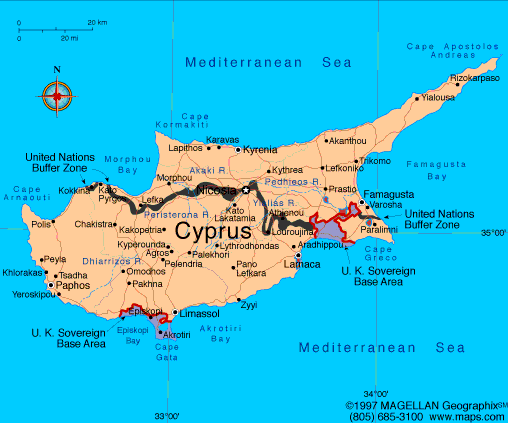CYPRUS

Geography: The third-largest island in the Mediterranean (one and one-half times the size of Delaware), Cyprus lies off the southern coast of Turkey and the western shore of Syria. The highest peak is Mount Olympus at 6,406 ft (1,953 m).
Government: Republic. Mediation efforts by the UN seek to reunify the Greek and Turkish areas of the island under one federated system of government.
History: Cyprus was the site of early Phoenician and Greek colonies. For centuries its rule passed through many hands. It fell to the Turks in 1571, and a large Turkish colony settled on the island.
In World War I, at the outbreak of hostilities with Turkey, Britain annexed the island. It was declared a Crown colony in 1925. The Greek population, which regarded Greece as its mother country, sought self-determination and union (enosis) with Greece. In 1955, a guerrilla war against British rule was launched by the National Organization of Cypriot Combatants (EOKA). In 1958, Greek Cypriot nationalist leader Archbishop Makarios began calling for Cypriot independence rather than union with Greece. During this period, Turkish Cypriots began demanding that the island be partitioned between the Greek and Turkish populations.
Cyprus became an independent nation on Aug. 16, 1960, after Greek and Turkish Cypriots agreed on a constitution, which excluded both the possibility of partition as well as of union with Greece. Makarios became the country's first president.
Fighting between Greek and Turkish Cypriots flared up in the early 1960s, and a UN peacekeeping force was sent to the island in 1965. On July 15, 1974, Archbishop Makarios was overthrown in a military coup led by the Cypriot National Guard. On July 20, Turkey invaded Cyprus, asserting its right to protect the Turkish Cypriot minority. Turkey gained control of 30% of northern Cyprus and displaced some 180,000 Greek Cypriots. A UN-sponsored cease-fire was established on July 22, and Turkish troops were permitted to remain in the north. In Dec. 1974, Makarios again assumed the presidency. The following year, the island was partitioned into Greek and Turkish territories separated by a UN-occupied buffer zone.
Turkish Cypriots proclaimed a separate state under Rauf Denktash in the northern part of the island on Nov. 15, 1983, naming it the “Turkish Republic of Northern Cyprus.” The UN Security Council, in its Resolution 541 of Nov. 18, 1983, declared this action illegal and called for withdrawal. No country except Turkey has recognized this entity.
In 1988, George Vassiliou, a conservative and critic of UN proposals to reunify Cyprus, became president. The purchase of missiles capable of reaching the Turkish coast evoked threats of retaliation from Turkey in 1997, and Cyprus's plans to deploy more missiles in Aug. 1999 again raised Turkey's ire.

Map of Cyprus
President: Nikos Anastasiadis (2013)
Land area: 3,568 sq mi (9,241 sq km);
total area: 3,571 sq mi
Population (2014 est.): 1,172,458 (growth
rate: 1.48%); birth rate: 11.44/1000; infant mortality rate: 8.54/1000;
life expectancy: 78.34
Capital and largest city (2011 est.):
Necosia 253,000
Monetary unit:
Euro
National
name: Kypriaki Dimokratia—Kibris Cumhuriyeti
Languages:
Greek, Turkish (both official); English
Ethnicity/race:
Greek 77%, Turkish 18% (each concentrated almost
exclusively in separate areas); other 5% (2001)
National Holiday:
Independence Day, October 1
Religions:
Greek Orthodox 78%, Islam 18%, Maronite, other
(includes Maronite and Armenian Apostolic) 4%
Literacy rate: 98.7% (2011 est.)
Economic summary: GDP/PPP: $21.62 billion (2013 est.); $24,500 per capita (2013 est.).
Real growth rate: –8.70%. Inflation: 0.2% (2013 est.). Unemployment:
17.4%. Arable land: 9.06%. Agriculture: citrus,
vegetables, barley, grapes, olives, vegetables; poultry, pork, lamb;
dairy, cheese. Labor force: 443,500 (2013); agriculture, 8.5%; industry, 20.5%; services, 71% (2006).
Industries: tourism, food and beverage processing, cement and
gypsum production, ship repair and refurbishment, textiles, light
chemicals, metal products, wood, paper, stone, and clay products.
Natural resources: copper, pyrites, asbestos, gypsum, timber,
salt, marble, clay earth pigment. Exports:
$2.42 billion (2013 est.). Imports: $4.747 billion (2013 est.).
Major trading partners: UK, Greece, Germany, France,
Italy, Israel, Netherlands, China (2006).
Member of Commonwealth of Nations
Communications: Telephones: main
lines in use: 373,200
(2012). Mobile cellular: 1.11 million (2012). Broadcast media:
mixture of state and privately run TV and radio services; the public
broadcaster operates 2 TV channels and 4 radio stations; 6 private TV
broadcasters, satellite and cable TV services including telecasts from
Greece and Turkey, and a number of private radio stations are available;
in areas administered by Turkish Cypriots, there are 2 public TV
stations, 4 public radio stations, and privately owned TV and radio
broadcast stations (2007). Internet hosts: 252,013 (2012).
Internet users: 433,900 (2009).
Transportation: Railways: 0 km.
Highways: 20,006 km; paved: 8,564; unpaved:
4,442 km (2011); under government control: 13,006 km (includes 2,277 km
of expressways); under Turkish Cypriot control: 7,000 km. Ports and harbors: area under government control: Larnaca, Limassol, Vasilikos; area administered by Turkish Cypriots: Famagusta, Kyrenia. Airports: 15
(2013).
International disputes:
hostilities in 1974 divided the island into two de facto
autonomous entities, the internationally recognized Cypriot Government
and a Turkish-Cypriot community (north Cyprus); the 1,000-strong UN
Peacekeeping Force in Cyprus (UNFICYP) has served in Cyprus since 1964
and maintains the buffer zone between north and south; on 1 May 2004,
Cyprus entered the European Union still divided, with the EU's body of
legislation and standards (acquis communitaire) suspended in the north;
Turkey protests Cypriot Government creating hydrocarbon blocks and
maritime boundary with Lebanon in March 2007.
-------------------- o --------------------
No comments:
Post a Comment